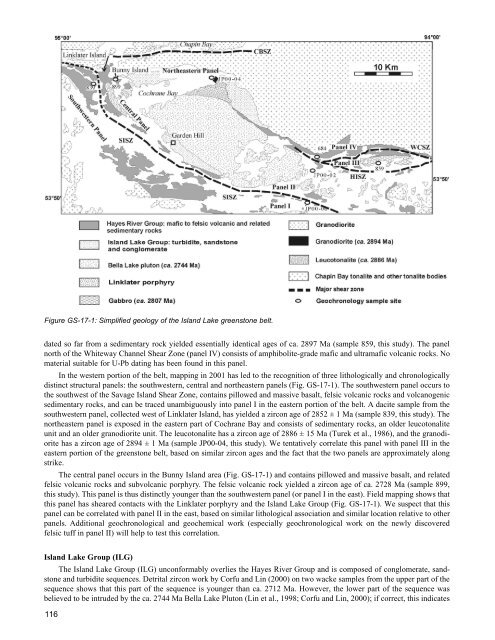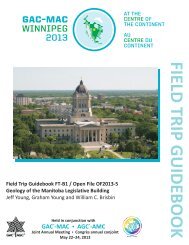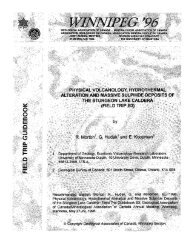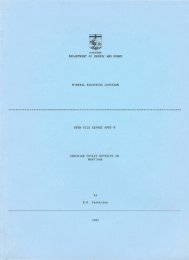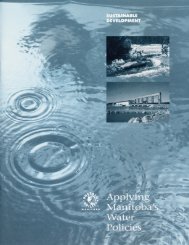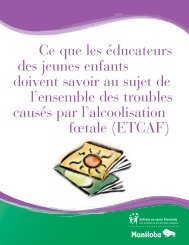Geology and Geochronology of the Island Lake Greenstone Belt ...
Geology and Geochronology of the Island Lake Greenstone Belt ...
Geology and Geochronology of the Island Lake Greenstone Belt ...
Create successful ePaper yourself
Turn your PDF publications into a flip-book with our unique Google optimized e-Paper software.
Figure GS-17-1: Simplified geology <strong>of</strong> <strong>the</strong> Isl<strong>and</strong> <strong>Lake</strong> greenstone belt.dated so far from a sedimentary rock yielded essentially identical ages <strong>of</strong> ca. 2897 Ma (sample 859, this study). The panelnorth <strong>of</strong> <strong>the</strong> Whiteway Channel Shear Zone (panel IV) consists <strong>of</strong> amphibolite-grade mafic <strong>and</strong> ultramafic volcanic rocks. Nomaterial suitable for U-Pb dating has been found in this panel.In <strong>the</strong> western portion <strong>of</strong> <strong>the</strong> belt, mapping in 2001 has led to <strong>the</strong> recognition <strong>of</strong> three lithologically <strong>and</strong> chronologicallydistinct structural panels: <strong>the</strong> southwestern, central <strong>and</strong> nor<strong>the</strong>astern panels (Fig. GS-17-1). The southwestern panel occurs to<strong>the</strong> southwest <strong>of</strong> <strong>the</strong> Savage Isl<strong>and</strong> Shear Zone, contains pillowed <strong>and</strong> massive basalt, felsic volcanic rocks <strong>and</strong> volcanogenicsedimentary rocks, <strong>and</strong> can be traced unambiguously into panel I in <strong>the</strong> eastern portion <strong>of</strong> <strong>the</strong> belt. A dacite sample from <strong>the</strong>southwestern panel, collected west <strong>of</strong> Linklater Isl<strong>and</strong>, has yielded a zircon age <strong>of</strong> 2852 ± 1 Ma (sample 839, this study). Thenor<strong>the</strong>astern panel is exposed in <strong>the</strong> eastern part <strong>of</strong> Cochrane Bay <strong>and</strong> consists <strong>of</strong> sedimentary rocks, an older leucotonaliteunit <strong>and</strong> an older granodiorite unit. The leucotonalite has a zircon age <strong>of</strong> 2886 ± 15 Ma (Turek et al., 1986), <strong>and</strong> <strong>the</strong> granodioritehas a zircon age <strong>of</strong> 2894 ± 1 Ma (sample JP00-04, this study). We tentatively correlate this panel with panel III in <strong>the</strong>eastern portion <strong>of</strong> <strong>the</strong> greenstone belt, based on similar zircon ages <strong>and</strong> <strong>the</strong> fact that <strong>the</strong> two panels are approximately alongstrike.The central panel occurs in <strong>the</strong> Bunny Isl<strong>and</strong> area (Fig. GS-17-1) <strong>and</strong> contains pillowed <strong>and</strong> massive basalt, <strong>and</strong> relatedfelsic volcanic rocks <strong>and</strong> subvolcanic porphyry. The felsic volcanic rock yielded a zircon age <strong>of</strong> ca. 2728 Ma (sample 899,this study). This panel is thus distinctly younger than <strong>the</strong> southwestern panel (or panel I in <strong>the</strong> east). Field mapping shows thatthis panel has sheared contacts with <strong>the</strong> Linklater porphyry <strong>and</strong> <strong>the</strong> Isl<strong>and</strong> <strong>Lake</strong> Group (Fig. GS-17-1). We suspect that thispanel can be correlated with panel II in <strong>the</strong> east, based on similar lithological association <strong>and</strong> similar location relative to o<strong>the</strong>rpanels. Additional geochronological <strong>and</strong> geochemical work (especially geochronological work on <strong>the</strong> newly discoveredfelsic tuff in panel II) will help to test this correlation.Isl<strong>and</strong> <strong>Lake</strong> Group (ILG)The Isl<strong>and</strong> <strong>Lake</strong> Group (ILG) unconformably overlies <strong>the</strong> Hayes River Group <strong>and</strong> is composed <strong>of</strong> conglomerate, s<strong>and</strong>stone<strong>and</strong> turbidite sequences. Detrital zircon work by Corfu <strong>and</strong> Lin (2000) on two wacke samples from <strong>the</strong> upper part <strong>of</strong> <strong>the</strong>sequence shows that this part <strong>of</strong> <strong>the</strong> sequence is younger than ca. 2712 Ma. However, <strong>the</strong> lower part <strong>of</strong> <strong>the</strong> sequence wasbelieved to be intruded by <strong>the</strong> ca. 2744 Ma Bella <strong>Lake</strong> Pluton (Lin et al., 1998; Corfu <strong>and</strong> Lin, 2000); if correct, this indicates116


